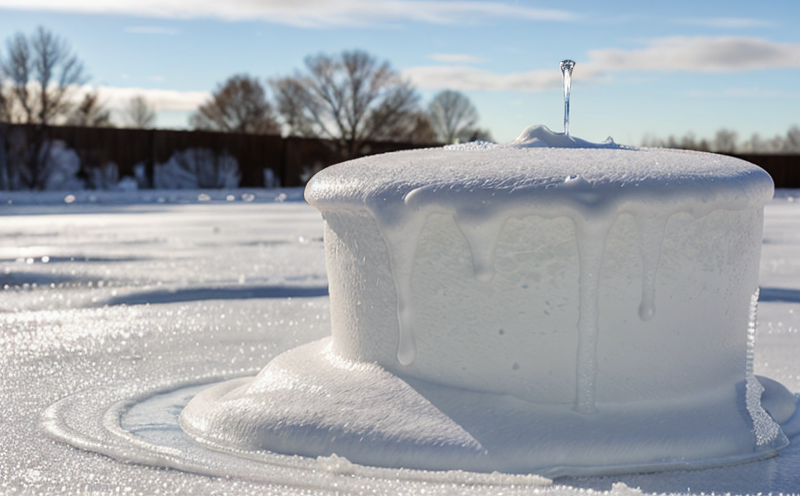EASA CS-25 Appendix C Aircraft Icing Condition Compliance Testing
The European Union Aviation Safety Agency (EASA) CS-25 is a regulation that specifies the design and construction requirements for transport category aircraft. EASA CS-25 Appendix C focuses on the structural icing conditions to ensure safe operation of these aircraft under severe weather conditions.
To comply with this requirement, testing must be conducted in controlled environments that simulate actual flight conditions. This involves exposing materials and components of an aircraft to artificial ice accretion, then evaluating their performance and durability post-exposure. The tests are critical for verifying the design integrity and ensuring safety margins against potential structural damage.
The EASA CS-25 Appendix C testing protocol is stringent and precise. It requires a controlled environment capable of replicating natural icing conditions, including temperature ranges from -40°C to +10°C, humidity levels, and specific wind velocities. The testing apparatus must also be able to simulate the aircraft's flight path through various icing scenarios.
One key aspect is the ice accretion on different components such as wings, fuselage, engines, and control surfaces. Ice accumulation can alter aerodynamic properties significantly, affecting stability and performance. By subjecting these critical parts to controlled icing conditions, we can assess their resistance to deformation and failure.
Another important consideration is the evaluation of de-icing systems. These systems are designed to remove accumulated ice from wings and other surfaces to restore aerodynamic efficiency. Testing ensures that these systems function effectively under various icing conditions without causing further damage or compromising safety.
The testing process involves rigorous calibration of equipment, precise control over environmental parameters, and careful monitoring throughout the test cycle. This ensures accurate results reflecting real-world flight conditions. Post-test analysis includes detailed inspections for any signs of structural deformation, material fatigue, or other anomalies that could affect airworthiness.
Compliance with EASA CS-25 Appendix C not only meets regulatory requirements but also enhances the reputation of aerospace manufacturers by demonstrating their commitment to safety and quality. It provides assurance that products meet stringent international standards, thereby increasing market confidence and competitive advantage in the global aviation industry.
Scope and Methodology
The scope of EASA CS-25 Appendix C testing encompasses a wide range of components essential for aircraft safety. It includes structural elements like wings, fuselage, empennage, engines, and other critical assemblies that may be exposed to icing conditions during flight.
- Wing Structures: Testing wing structures involves simulating ice accretion on the leading edge and upper surface. This helps in evaluating the structural integrity and aerodynamic performance post-icing.
- Fuselage Surfaces: The fuselage plays a crucial role in maintaining airframe shape and stability. Tests focus on the front section where icing is most likely to occur, ensuring that ice does not compromise overall aircraft design.
- Engine Inlets: Engine inlet testing ensures that ice accumulation does not interfere with airflow into the engine, which could lead to compressor stall or other catastrophic failures.
- Control Surfaces: Control surfaces such as ailerons and elevators are tested for their ability to operate effectively through icing conditions. Ice build-up can significantly affect maneuverability and control authority.
The methodology involves precise calibration of the test rig, ensuring it replicates real-world flight paths and environmental conditions accurately. The testing process typically starts with an initial baseline inspection before exposing the sample to controlled icing conditions. Post-exposure inspections are conducted to assess changes in shape, material properties, and performance metrics.
Acceptance criteria for EASA CS-25 Appendix C compliance involve meeting specific standards outlined by international bodies such as ISO 10837 for ice accretion simulation and ASTM D4586 for de-icing system testing. Compliance also requires validation through detailed documentation of test procedures, results, and conclusions.
Eurolab Advantages
Eurolab offers comprehensive capabilities to perform EASA CS-25 Appendix C compliance testing with unmatched precision and reliability. Our state-of-the-art facilities provide controlled environments capable of simulating a wide range of icing conditions, ensuring that tests are representative of real-world scenarios.
- Expertise: Our team comprises highly skilled engineers and technicians specializing in aerospace testing with extensive experience in meeting EASA standards.
- Technology: Utilizing advanced instrumentation, including laser scanning systems for detailed post-test inspections, we ensure accurate and repeatable test results.
- Compliance: Our testing protocols are meticulously designed to meet the stringent requirements of EASA CS-25 Appendix C, providing assurance that all regulatory obligations are fulfilled.
We offer a full-service approach, from initial consultation on test methods and procedures to detailed reporting and certification. This comprehensive service ensures that our clients can confidently demonstrate compliance with international standards, enhancing their product safety reputation in the market.
Use Cases and Application Examples
- Airframe Design Validation: Ensuring that new aircraft designs can withstand severe icing conditions without compromising structural integrity or aerodynamic performance.
- Maintenance Protocol Development: Establishing robust maintenance procedures to de-ice aircraft components effectively and safely.
- New Component Testing: Evaluating newly developed parts for their ability to operate under icing conditions, ensuring they meet safety standards before deployment.
- Regulatory Compliance: Demonstrating compliance with EASA CS-25 Appendix C requirements for ongoing certification and re-certification of aircraft models.
These tests are vital not only for new product development but also for maintaining the safety and reliability of existing fleets. By adhering to these rigorous testing protocols, manufacturers can enhance their products' reputation for quality and safety in a competitive market environment.





